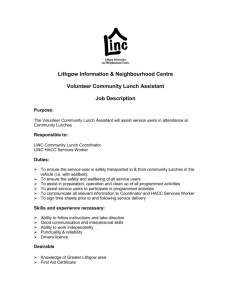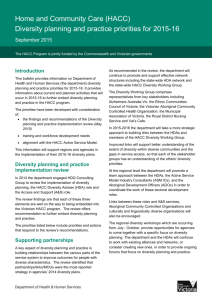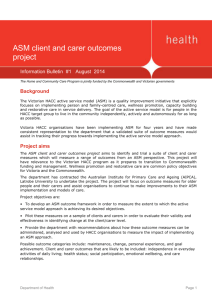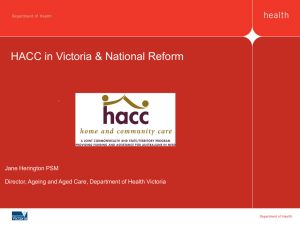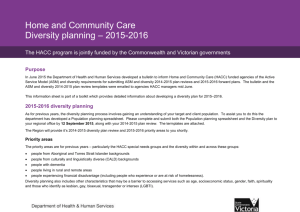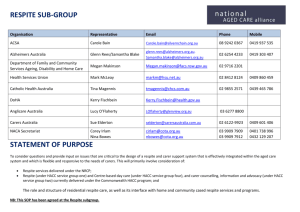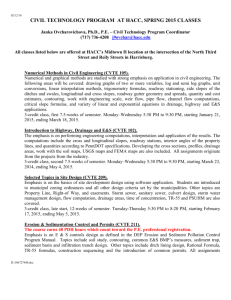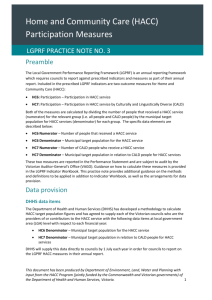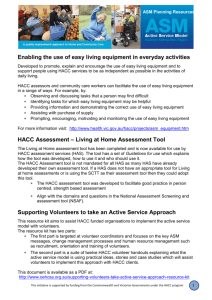Grampians Region HACC Diversity Plan
advertisement
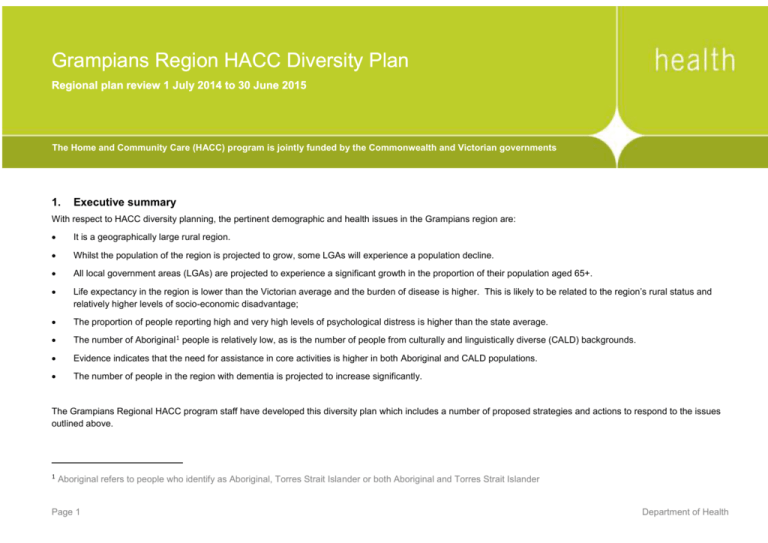
Grampians Region HACC Diversity Plan Regional plan review 1 July 2014 to 30 June 2015 The Home and Community Care (HACC) program is jointly funded by the Commonwealth and Victorian governments 1. Executive summary With respect to HACC diversity planning, the pertinent demographic and health issues in the Grampians region are: It is a geographically large rural region. Whilst the population of the region is projected to grow, some LGAs will experience a population decline. All local government areas (LGAs) are projected to experience a significant growth in the proportion of their population aged 65+. Life expectancy in the region is lower than the Victorian average and the burden of disease is higher. This is likely to be related to the region’s rural status and relatively higher levels of socio-economic disadvantage; The proportion of people reporting high and very high levels of psychological distress is higher than the state average. The number of Aboriginal1 people is relatively low, as is the number of people from culturally and linguistically diverse (CALD) backgrounds. Evidence indicates that the need for assistance in core activities is higher in both Aboriginal and CALD populations. The number of people in the region with dementia is projected to increase significantly. The Grampians Regional HACC program staff have developed this diversity plan which includes a number of proposed strategies and actions to respond to the issues outlined above. 1 Aboriginal refers to people who identify as Aboriginal, Torres Strait Islander or both Aboriginal and Torres Strait Islander Page 1 Department of Health Summary of Evidence 2. 1st Year 2.1 2nd Year 3rd Year Quantitative data sources Quantitative data Data source The population of the region is projected to grow by nearly 20% by 2026. Department of Health (2010) Projected Population Change in Victoria. Victorian State Government, Melbourne. Some LGAs will experience population decline. All LGAs are projected to experience a significant increase in the proportion of their population aged 65+ by 2026. ibid. Department of Planning and Community Development (2009) Victoria in Future 2008. Department of Planning and Community Development, Melbourne. Although the proportion of people in the region from Aboriginal backgrounds is higher than the Victorian average, in absolute numbers it represents fewer than 2,200 people. Department of Health (2011) Local Government Areas 2010 Statistical Profiles. Victorian State Government, Melbourne. Evidence consistently demonstrates that Aboriginal people have significantly poorer health outcomes than the general population. Australian Institute of Health and Welfare (2010) Australia’s Health 2010. AIHW, Canberra. In the Grampians region the proportion of people from CALD backgrounds is significantly lower than the Victorian average (measured by the percentage born overseas, English proficiency and numbers of ‘New Settlers’). Department of Health (2011) Local Government Areas 2010 Statistical Profiles. Victorian State Government, Melbourne. Evidence suggests that the proportion of the population from CALD backgrounds is likely to increase and also likely to age faster than the general population. Jirowong, S. and Liamputtong, P. (2009) ‘Primary Health Care and Health Promotion’ in Population Health, Communities and Health Promotion. S. Jirowong and P. Liamputtong (Eds). Oxford University Press, Melbourne. In Aboriginal populations the need for assistance with core activities is higher than the general population, across all age groups. In CALD populations the need for assistance is higher than the general population in those aged 45+. 2006 Census of Population and Housing, Australian Bureau of Statistics (ABS) Page 2 (using data from the 2006 Census and the Department of Immigration and Citizenship) Department of Health Quantitative data Data source Projections suggest that the proportion of the population with dementia will increase and that increase will be higher in regional areas. In the Grampians region the number of people with dementia is expected to nearly quadruple by 2050. Access Economics (2009) Keeping Dementia Front of Mind: incidence and prevalence 2009-2050. Report prepared for Alzheimer’s Australia. Grampians is a rural region and evidence indicates that rural and remote communities have poorer health outcomes than those in metropolitan areas. Life expectancy within the region is lower than for Victoria and the burden of disease (measured in Disability Adjusted Life Years) is higher. Australian Institute of Health and Welfare (2008). Rural, Regional and Remote Health: indicators of health status and the determinants of health. Rural Health Series no. 9. AIHW, Canberra. The percentage of people reporting high or very high rates of psychological distress is higher in the region than the Victorian average. Department of Health (2009) Victorian Population Health Survey 2008. Victorian State Government, Melbourne. There is a strong link between socio-economic status (SES) and health. SES can be measured by unemployment, income, education or a combination of these and other indicators (e.g. IRSED). Using any of these measures, Grampians region has poorer SES indicators than Victorian figures. Department of Health (2011) Local Government Areas 2010 Statistical Profiles. DH, Melbourne. With rates of home ownership declining among older Australians, and with all LGAs in the region projected to experience a significant increase in the proportion of their population aged 65+ by 2026, the number of older people at risk of, and experiencing homelessness is also expected to increase significantly. Australian Bureau of Statistics (2011) Census of Population and Housing: Estimating homelessness: 2049.0. ABS, Canberra. Evidence indicates that in addition to higher rates of mental illness, people who are homeless experience poor dental health, eye problems, podiatry issues, infectious diseases, sexually transmitted disease, pneumonia, lack of preventive and routine health care and inappropriate use of medication. Homelessness Taskforce: Department of Families, Housing, Community Services and Indigenous Affairs (2008) The Road Home: A National Approach to Reducing Homelessness, Commonwealth of Australia, Canberra. Health literacy enables communication and participation in health care. Fifty nine per cent of Australian adults were identified as having a low health literacy level at an inadequate level to meet the demands of everyday life (Australian Bureau of Statistics 2006). Department of Health (2013) Health literacy: enabling communication and participation in health, Victorian State Government, Melbourne Page 3 Access Economics (2010) Projections of dementia prevalence and incidence in Victoria 2010 – 2050: Department of Health Regions and Statistical Local Areas. Report prepared for Alzheimer’s Australia. Department of Health (2011) Local Government Areas 2010 Statistical Profiles. Victorian State Government, Melbourne. Australian Bureau of Statistics (2008) Census of Population and Housing: Socio-Economic Indexes for Areas (SEIFA): 2033.0.55.001. ABS, Canberra. Wilkinson, R. and Marmot, M. (2003) Social Determinants of Health: the Solid Facts 2nd edition. World Health Organization, Copenhagen. Homelessness Australia (2013) Homelessness and Older People Fact Sheet Department of Health (2013) Local Government Areas 2012 Statistical Profiles. DH, Melbourne. Department of Health Health literacy is impeded by a range of determinants including socioeconomic status, disability, remote or rural habitation. Evidence indicates that the Grampians region has a higher representation of people in these groups than Victorian figures. Understanding the diversity of the region’s population is fundamental in developing capability to engage the community to inform service planning and provision. Strategies to scope population, analyse data and undertake community engagement were generally omitted by HACC providers in their diversity plans. Only one third of providers included strategies under this diversity goal. 2.2 Department of Sustainability and Environment (2013) Introduction to engagement Department of Health HACC agency Diversity Planning – monitoring checklist and regional summary (2013 – 2014) Qualitative data sources Qualitative data Data source Feedback from service providers suggests that a number of HACC assessment officers feel uncomfortable completing the psycho-social component of the HACC assessments (see diversity goal 6) Consultation with service providers. Feedback from service providers indicates that they are witnessing an increase in the number of clients with psycho-social issues. HACC providers have identified the need for clearer links and knowledge of referral pathways. (see diversity goal 6) Consultation with service providers Feedback from service providers indicates that they are witnessing an increase in the number of clients with dementia. They express some concern regarding access to services for those clients, their families and carers (see diversity goal 1) Consultation with service providers. Feedback from service providers indicates that people with dementia and their families are presenting to services in crisis. Service providers have identified that earlier interventions are required to reduce carer burden and enhance the quality of life for the person with dementia (see diversity goal 1) Consultation with service providers Page 4 Department of Health HACC providers have identified the need for clearer links and stronger relationships between themselves and the region’s Aboriginal Community Controlled Organisations (ACCOs) to improve client access to services (see diversity goal 2) Feedback from service providers. Feedback from 1st year diversity plans highlights the improved relationships between HACC Assessment Services (HAS) and Aboriginal Community Controlled Organisations (ACCOs) as a result of the Partnering project. Non-HAS providers have indicated the need to broaden the work from the Partnering project to all HACC providers (see diversity goal 2) Feedback from service providers HACC providers have identified unmet allied health needs of Supported Residential Services (SRS) residents especially in the area of podiatry (see diversity goal 4) Consultation with service providers. HACC funded organisations indicated that as part of the implementation of their initial diversity plans, they would be interested in undertaking diversity audits for specific special needs groups such as gay, lesbian, bisexual, transgender and intersex (GLBTI) people (see diversity goal 7) Consultation with service providers There appears to be an emerging trend of those people who are financially disadvantaged moving to small rural communities due to the availability of relatively inexpensive housing (see diversity goal 7) Consultation with service providers HACC providers have identified the need to improve recording of Minimum Data Set (MDS) data relating to special needs groups and to implement processes that will assist with the monitoring and evaluation of the impacts and outcomes of diversity planning (see diversity goal 8) Feedback from service providers Feedback from service providers suggests that stronger skills in data interpretation and community engagement are needed to further understand the profile of their diverse communities and to ensure that the voice of consumers informs service planning and improvement (see diversity goal 7) Consultation with service providers Page 5 Department of Health 2.3 Interpretation of analysis Commentary and issues identified Source of information used Possible priority In all LGAs the proportion of the population aged 65+ is expected to increase significantly. In some LGAs this will occur at the same time as a decline in the working aged population. Department of Planning and Community Development Discussion with funded organisations about strategic response to potential increased demand coupled with workforce shortages. The number of people with dementia is projected to increase significantly in all LGAs in the region. Access Economics reports Improving knowledge about dementia services across the regions – for all stakeholders including funded services, people with dementia, their families and carers Some HACC assessment officers reportedly have issues completing the psycho-social component of the assessment tools. This may mean that opportunities for the early identification of clients with psycho-social issues are missed. Consultation with funded agencies HACC assessment officers provided with training in psychosocial assessment and appropriate referral pathways Actual numbers of Aboriginal people are small but their need for assistance is higher than the general population. Improving partnerships between HACC agencies and the region’s ACCOs would enhance service coordination and therefore outcomes for clients. Department of Health central office data Scope issues and explore possible opportunities for action. Include possible activities to improve partnerships between organisations. The number of people from CALD backgrounds is reportedly low in the region. However, exact numbers are not known. Evidence suggests that in populations aged 45+ their need for assistance is higher than the general population. Department of Health central office data Scope issues and explore possible opportunities for action (including strategies that may have been successful in similar regions). This may include the collation of information from funded agencies regarding the number of clients from CALD backgrounds. Many HACC providers reportedly experience issues with capturing MDS data on special needs groups. Identified gaps in MDS data support this issue. This may mean that opportunities for service planning and improvements are missed. Consultation with funded agencies Explore possible opportunities to improve data collection and provide agencies with training on how to turn data into meaningful information. Many HACC providers have demonstrated little or no progress toward implementation of strategies to identify access barriers. Department of Health regional summary Page 6 Department of Health data Improving community engagement skills with HACC managers and providing supporting resources. Department of Health Grampians Region Diversity Plan 2012-15 - Diversity planning review 1st Year 2nd Year Priority/goal (Reflecting the Victorian Government’s health priorities and HACC priorities) 1. DEMENTIA: Address Heath Priority Two ‘improving every Victorian’s health status and experiences’ by improving access to person centred and enabling services for HACC eligible people with dementia their families and carers. 3rd Year What we want to achieve over the three years Strategies/actions Timeframe (Years 1- 3) (Measurable outcomes) Outcome: Implemented Partially implemented, or Not implemented. Key achievements, barriers and/or challenges. Improve the response to people with dementia, their families and carers by enhancing the understanding of dementia services in the region and increasing knowledge about appropriate referral pathways. Establish a regional dementia advisory group. Year 1 Implemented - Key achievements included: The regional dementia advisory group assisted with identifying priority areas of work and developing strategies to improve referral pathways and increased awareness of dementia across the region. Encourage HACC funded organisations to participate in, and consult with the Regional Dementia Advisory group, specialist service organisations and programs to support referral processes and improve dementia friendly environments and practice within the region. Specialist and HACC funded organisations supported and participated in the development of regional resources and referral pathways including: Grey Matters: A guide to living well with dementia and memory loss in the Grampians Region Regional dementia tool kit Implemented Year 2 The regional dementia advisory group identified the need to develop a Grampians region GP Dementia Pathway online tool in an effort to achieve timely diagnosis and referral. Specialist and HACC providers contributed to the development of the pathway, a partnership project between the Department of Health, Grampians Medicare Local, Ballarat Health Services and Federation University http://www.grampiansml.com.au/dpp Map available services including support groups in the region – for those with dementia, their families and carers. Page 7 Year 1 Implemented Consultation period undertaken to map available services Information used to inform development of regional dementia resources Department of Health Priority/goal (Reflecting the Victorian Government’s health priorities and HACC priorities) 1. DEMENTIA: Address Heath Priority Two ‘improving every Victorian’s health status and experiences’ by improving access to person centred and enabling services for HACC eligible people with dementia their families and carers. Continued What we want to achieve over the three years Strategies/actions Timeframe (Years 1- 3) (Measurable outcomes) Outcome: Implemented Partially implemented, or Not implemented. Key achievements, barriers and/or challenges. Identify and document service gaps, or areas of duplication, in the region. Year 1 Implemented Service gaps identified, documented and discussed with the regional dementia advisory group. Development of regional resources and partnership work with Medicare Locals and specialist services has addressed some identified service gaps Partially implemented Year 2 Further work occurring to explore feasibility of implementing new Dementia Support Nurse role and improved attendance at Memory Lane Cafes to close service gaps Dementia Support Nurse role advertised. The position will sit at Stawell Regional health and support Northern Grampians catchment Identify challenges that organisations face in delivering services to people with dementia or cognitive impairment, including awareness of appropriate referral pathways Year 3 Identified service gaps have been tabled for discussion at forums and dementia network meetings Year 1 Implemented Regional resources have assisted in raising awareness of appropriate referral pathways Partially implemented Year 2 Feedback from agency consultations suggests that the stigma surrounding dementia continues to be a barrier to people accessing services and a challenge for HACC funded organisations to raise awareness. Work will continue with HACC funded organisations to identify challenges to inform planning and promote use of regional resources to help reduce stigma Page 8 Department of Health Priority/goal (Reflecting the Victorian Government’s health priorities and HACC priorities) What we want to achieve over the three years Strategies/actions Timeframe (Years 1- 3) (Measurable outcomes) Outcome: Implemented Partially implemented, or Not implemented. Key achievements, barriers and/or challenges. 1. DEMENTIA: Address Heath Priority Two ‘improving every Victorian’s health status and experiences’ by improving access to person centred and enabling services for HACC eligible people with dementia their families and carers. Continued Promote the uptake of the relevant accredited dementia competency units, either as a single stand alone unit or as part of a Certificate qualification, to relevant staff working in HACC funded programs. Year 1 Implemented Training opportunities promoted. Some HACC funded organisations have now placed dementia e3learning as an annual mandatory training requirement Year 2 Partially implemented Working with training bodies to explore possibility of delivering a dementia skill set. Will continue to promote training opportunities to HACC funded organisations as they arise Work with HACC funded organisations to explore personalised support options for younger people with dementia. Year 2 Collaborating with younger onset dementia (YOD) key worker at Alzheimer’s Australia Victoria (AAV) to explore respite options for younger people with dementia Year 3 Increasing dementia friendly and enabling environments and practice within regional HACC funded social support and respite programs. Promote the use of education resources and appropriate tools that are available to progress dementia friendly and enabling environments and practices within HACC social support and respite programs. Partially implemented Year 1 YOD dementia advocate and key worker will be guest speakers at the June 2014 Diversity forum. YOD data to be shared and support options explored at the forum to help inform service planning and organisation diversity plan strategies Partially implemented The Department of Health Dementia Friendly Environments Guide promoted and circulated to HACC funded organisations Further education resources and checklists to be developed collaboratively with IC during year 2 Partially implemented Year 2 Page 9 “Information about me” handbook available March 2014. Promotional work to be undertaken with the Active Service Model (ASM) Industry Consultant (IC) and HACC funded organisations at network meetings and forums Department of Health Priority/goal (Reflecting the Victorian Government’s health priorities and HACC priorities) 1. DEMENTIA: Address Heath Priority Two ‘improving every Victorian’s health status and experiences’ by improving access to person centred and enabling services for HACC eligible people with dementia their families and carers. Continued What we want to achieve over the three years Strategies/actions Timeframe (Years 1- 3) (Measurable outcomes) Outcome: Implemented Partially implemented, or Not implemented. Key achievements, barriers and/or challenges. Work with HACC funded organisations to explore flexible service responses for people with dementia displaying behaviours of concern Year 2 Not implemented The HACC Diversity Adviser (HDA) will explore opportunities to collaborate with Dementia Behaviour Management Advisory Service (DBMAS), planned activity group (PAG) managers network and IC to identify activities that support or minimise behaviours of concern where low level PAG is the only available respite option Year 3 Encourage HACC funded organisations to identify personal development opportunities for social support and respite program staff to better enable them to demystify dementia for clients and carers. Year 1 Implemented All HACC funded organisations encouraged to circulate the ‘Grey Matters’ guide to staff. The AAV “Worried about your Memory” checklist included in the regional dementia tool kit as a tool for staff to initiate conversation and measure concerns Year 2 Partially implemented HDA and the IC, will utilise the PAG network, PAG forum in April and the Diversity forum June 2014 to further progress this strategy Investigate the possibility of implementing Montessori in the home pilots in the region based on the City of Greater Dandenong (CoGD) project and explore opportunity for Chisholm to include Montessori training on the HACC calendar Page 10 Year 3 Promote uptake of identified personal development opportunities across the region Year 2 – 3 Partially implemented Initial discussions held with CoGD staff and HACC funded organisations that could take part in the pilots Department of Health Priority/goal (Reflecting the Victorian Government’s health priorities and HACC priorities) 2. ABORIGINAL: Address Heath Priority One ‘developing a system that is responsive to peoples needs’, improve access for Aboriginal clients to HACC funded services. What we want to achieve over the three years Strategies/actions Timeframe (Years 1- 3) (Measurable outcomes) Outcome: Implemented Partially implemented, or Not implemented. Key achievements, barriers and/or challenges. Improve access to person centred and enabling services for eligible Aboriginal people by strengthening the relationships between HACC funded Living at Home Assessment organisations and the three ACCOs in the region. Develop and endorse a project plan (to improve partnerships). Year 1 Ensure commitment and participation of relevant HACC funded organisations and ACCO’S. Year 1 Implemented Project plans developed and reviewed annually Implemented All relevant HACC funded organisations and ACCO’s contributed to the partnership Budja Budja Aboriginal Co-operative is no longer HACC funded which may impact on partnerships in the Grampians Pyrenees catchment. Facilitate four forums – one for each ACCO and the HACC Living at Home Assessment services in their catchment, to identify activities that will improve partnerships. Year 1 Implemented Activities identified in year 1 with work continuing into year 2 Year 2 Implemented Key achievements include: the development of an assessment prompt sheet in the Wimmera which has been adopted across the region the development of a regional pamphlet promoting assessment choices the delivery of ‘identifying as Aboriginal’ training for Living at Home Assessment officers perceived improvement in partnerships between HACC funded organisations and ACCO’s Page 11 Department of Health Priority/goal (Reflecting the Victorian Government’s health priorities and HACC priorities) 2. ABORIGINAL: Address Heath Priority One ‘developing a system that is responsive to peoples needs’, improve access for Aboriginal clients to HACC funded services. Continued Page 12 What we want to achieve over the three years Strategies/actions Timeframe (Years 1- 3) (Measurable outcomes) Outcome: Implemented Partially implemented, or Not implemented. Key achievements, barriers and/or challenges. Monitor the implementation of identified partnering activities. Year 2 – 3 Improve the cultural competence of HACC funded organisations to ensure Aboriginal culturally responsive and culturally safe responses, for example through promotion of the Aboriginal cultural competence audit tool and resource kit adapted from the Gippsland Framework Year 2 Year 3 HACC funded organisations undertake reflective practices through implementation of the cultural competence audit tool Explore opportunities to increase knowledge and awareness of Aboriginal people through the provision of cultural awareness training and identifying as Aboriginal training Year 2 – 3 Partially implemented Promote HACC services and provide health promotion education to Aboriginal people in the HACC target group Year 2 – 3 Implemented and ongoing Activities monitored as part of annual project plan review Partially implemented The HDA is working with the Aboriginal HACC Development Officer to review and adapt the cultural competence framework quality improvement audit tool Initial consultation held with Aboriginal HACC Development Officer and ACCOs Further work to be undertaken in year 3 Partially implemented Currently exploring opportunities for AAV to provide dementia awareness sessions to Aboriginal Elders and ACCO staff Department of Health Priority/goal (Reflecting the Victorian Government’s health priorities and HACC priorities) 3. CALD: Address Heath Priority Two ‘improving every Victorian’s health status and experiences’ by improving access to person centred and enabling services for HACC eligible people from CALD backgrounds. What we want to achieve over the three years Strategies/actions Timeframe (Years 1- 3) (Measurable outcomes) Outcome: Implemented Partially implemented, or Not implemented. Key achievements, barriers and/or challenges. Increase service access for eligible clients from CALD backgrounds by providing services that are evidence based, personalised and culturally appropriate. Work with HACC funded organisations to develop evidence regarding number of potential clients from CALD backgrounds. Year 2 Scope issues and explore possible opportunities for action. Year 2 Partially implemented Central office data disseminated to HACC funded organisations Partially implemented The HDA continues to attend the Ethnic Communities Council of Victoria (ECCV) and local Culturally Inclusive Aged Care Committee (CIACC) meetings Issues explored during CIACC will inform planning Develop strategies for service improvements based on the accumulated evidence. Year 2 – 3 Partially implemented Current strategies identified for the next year to improve service delivery include: The HDA to continue to work with the Access and Support worker Explore health literacy training opportunities Victorian Interpreting and Translation Service (VITS) invited as a guest speaker at the June 2014 Diversity forum Page 13 Improve data reporting consistency by HACC funded organisations of CALD MDS items Year 2 Promote the development and dissemination of HACC information which reflects culturally appropriate language, concepts and values of existing and emerging CALD populations through partnership Year 2 – 3 Partially implemented Consulted with HACC funded organisations that have made improvements in data reporting with the aim to disseminate information Partially implemented Discussions with Ballarat Regional Multicultural council to adapt and share local community profiles across the region Department of Health approaches with ethno-specific or multicultural agencies. Priority/goal (Reflecting the Victorian Government’s health priorities and HACC priorities) What we want to achieve over the three years Page 14 Timeframe (Years 1- 3) (Measurable outcomes) Outcome: Implemented Partially implemented, or Not implemented. Key achievements, barriers and/or challenges. 3. CALD: Address Heath Priority Two ‘improving every Victorian’s health status and experiences’ by improving access to services for HACC eligible people from CALD backgrounds. Continued 4. GENERAL: Address Health Priority Two ‘improving every Victorian’s health status and experiences’ by improving access to person centred and enabling services for HACC eligible people experiencing financial disadvantage (including people who are homeless or at risk of homelessness). Strategies/actions Increase service access for eligible clients from Supported Residential Services by providing allied health services that are evidence based. Develop and deliver opportunities for HACC funded organisations to increase their knowledge of interpreter services and how to access same. Year 2 Review data related to emerging settlement planning trends to inform future service demand Year 3 Work with HACC funded organisations to develop evidence regarding the number of potential clients from SRS facilities. Year 1 Scope issues and explore possible opportunities for action. Year 1 Partially implemented Initial planning discussions held with VITS VITS will be providing an information session at the Diversity forum in June 2014. The session will include “Tips on Working with Interpreters and Cross-cultural Communication” Implemented Steering group formed. Evidence gathered from HACC funded organisations and SRS facilities. Implemented Initial podiatry assessment of all SRS clients undertaken between the two podiatry organisations funded in Ballarat to deliver allied health services for the project. Issues identified and solutions implemented. Department of Health Priority/goal (Reflecting the Victorian Government’s health priorities and HACC priorities) What we want to achieve over the three years Timeframe (Years 1- 3) (Measurable outcomes) Outcome: Implemented Partially implemented, or Not implemented. Key achievements, barriers and/or challenges. GENERAL: Address Health Priority Two ‘improving every Victorian’s health status and experiences’ by improving access to person centred and enabling services for HACC eligible people experiencing financial disadvantage (including people who are homeless or at risk of homelessness). Continued Improved access, delivery and expansion of services to HACC eligible people who are financially disadvantaged, homeless or living in insecure accommodation, as measured by the HACC MDS. Page 15 Strategies/actions Develop a plan for service delivery based on accumulated evidence. Year 1-2 Consult with the Grampians region Homeless Coordinator to obtain additional data from the housing sector to develop regional information in relation to homelessness experienced by HACC eligible people. Year 2 Collaborate with the Grampians region Homeless Coordinator to promote referral pathways, service coordination practices and networks between HACC funded organisations and housing services. Year 2 – 3 Work with the Access and Support worker, housing programs and Grampians region Homeless Coordinator to investigate flexible service responses and service delivery models specific to the needs Year 2 – 3 Implemented and ongoing Plan developed. Ongoing podiatry services delivered and sustainable. Partially implemented Planning discussions held with the Homeless Coordinator. Information to be shared at June 2014 Diversity forum Partially implemented Planning discussions held The regional Homeless Coordinator will utilise the Diversity forum in June 2014 to promote pathways and assessment and referral practices Partially implemented Access and Support worker role commenced in the region December 2013. Early discussions held. Further work to be undertaken in year 3 Department of Health of this group. Priority/goal (Reflecting the Victorian Government’s health priorities and HACC priorities) 5. RURAL AND REMOTE: Address Health Priority Two ‘improving every Victorian’s health status and experiences’ by improving access to person centred and enabling services for HACC eligible people living in rural and remote areas. What we want to achieve over the three years Strategies/actions Timeframe (Years 1- 3) (Measurable outcomes) Key achievements, barriers and/or challenges. Improve the service response to people living in rural and remote areas of the region to increase opportunities to reduce social isolation. Increase service access for eligible clients from rural and remote areas by providing service delivery models applicable to isolated people and small communities Work with HACC funded organisations to develop evidence regarding the number of potential socially isolated clients living in their individual local government catchments. Year 1 Scope and explore possible opportunities for action. Years 1-2 Work with HACC funded organisations to develop strategies for service improvements based on the accumulated evidence Year 1-2 Consider workforce recruitment strategies for community care workers and allied health staff utilising HWA Workforce Innovation: Caring for Older People Program report and learning module. Partially implemented Work undertaken with assessment staff to identify potential socially isolated clients Not implemented Requires further consultation with HACC funded organisations Partially implemented Allied Health targets analysed. Evidence identified the need to implement a project in the west of the region to improve access to allied health services. West Wimmera, Hindmarsh and Yarriambiack (WHY) project implemented and ongoing Year 3 Page 16 Outcome: Implemented Partially implemented, or Not implemented. Evaluate WHY project and identify further areas of work Year 3 Department of Health Priority/goal (Reflecting the Victorian Government’s health priorities and HACC priorities) 6: GENERAL: Address Heath Priority One ‘developing a system that is responsive to people’s needs’ by improving the services responses to HACC eligible people with possible mental health issues. Page 17 What we want to achieve over the three years Strategies/actions Timeframe (Years 1- 3) (Measurable outcomes) Outcome: Implemented Partially implemented, or Not implemented. Key achievements, barriers and/or challenges. Improve the capacity of HACC assessment and community care staff to respond effectively to clients with possible mental health issues. Establish a working group to develop and lead project (including Psycho Geriatric services from the Area Mental Health Service). Year 1 Develop and deliver opportunities for HACC Assessment staff to increase their knowledge and skills to enable them to respond effectively to clients with possible mental health issues. Year 1 Develop opportunities for HACC community care workers to increase their knowledge and skills to enable them to respond effectively to clients with possible mental health issues. Year 1 Promote National Workforce training funding obtained by the former regional HACC training coordinator and Federation University to deliver “Alcohol and Other Drugs” skill set to HACC funded organisations Year 2 Implemented Working group established and partnerships between Mental Health Service and HACC funded organisations strengthened Implemented K10 training delivered to HACC managers and assessment staff by Area Mental Health Service Assessment staff reporting increased use of K10 with clients resulting in increase referrals to general practice and counseling services Implemented Mental health is your business training available and delivered to HACC managers, assessors and Community Care Workers. Strong uptake of training across the region Partially implemented Expressions of interest received HAS assessment staff to commence skill set mid 2014 Department of Health Priority/goal (Reflecting the Victorian Government’s health priorities and HACC priorities) What we want to achieve over the three years Strategies/actions Timeframe (Years 1- 3) (Measurable outcomes) Key achievements, barriers and/or challenges. Seek further opportunities to partner with Area Mental Health Service to raise awareness and promote referral pathways to mental health services across the region Year 2 Increase consumer engagement and participation to understand the access issues for HACC special needs groups to ensure the voice of consumers informs service planning and improvement. Identify appropriate tools for use by HACC funded organisations to assist them to understand and address access issues for special needs groups. Partially implemented Mental health e3 learning module developed and due for release February 2014 Promotion of new learning resource at network meetings and regional forums Year 3 7. GENERAL: Address Health Priority One ‘Developing a system that is responsive to people’s needs’, identify HACC special need groups that are encountering access barriers to HACC services. Outcome: Implemented Partially implemented, or Not implemented. Year 1-2 Engaging HACC in Mental health discharge planning project Partially implemented Challenge - Many HACC funded organisations failed to include community engagement opportunities to identify access barriers in their diversity plans To assist HACC funded organisations a questionnaire to assist with identifying access barriers experienced by special needs groups is currently being developed Questionnaire is in draft form and will be shared with HACC funded organisations early 2014 for comment and feedback Collate access issues from HACC funded organisations for inclusion in the next regional diversity plan. Page 18 Year 3 Department of Health Priority/goal (Reflecting the Victorian Government’s health priorities and HACC priorities) Page 19 What we want to achieve over the three years Strategies/actions Timeframe (Years 1- 3) (Measurable outcomes) Outcome: Implemented Partially implemented, or Not implemented. Key achievements, barriers and/or challenges. In collaboration with the Access and Support worker and in accordance with the Grampians Region Diversity Plan and organisation specific diversity plans, scope and respond to identified access barriers experienced by the agreed Access and Support catchment and target group. Year 2 – 3 Develop and deliver opportunities for HACC funded organisations to increase their knowledge and skills in health literacy to improve communication material and key messages to HACC special need groups. Year 3 Seek opportunity to work with Grampians Medicare Local to promote the HACC sector through General Practitioner and Practice Nurse education. Year 3 Partially implemented Access and Support worker commenced December 2013 MDS reporting and monthly reference group meetings commenced January 2014. Information will inform planning and further areas of work for year 3 Department of Health Priority/goal (Reflecting the Victorian Government’s health priorities and HACC priorities) 8. CONTINUOUS IMPROVEMENT: In accordance with the Victorian Health priority of ‘implementing continuous improvements and innovation’ and ‘increasing accountability and transparency’, monitor and evaluate the impacts and outcomes of this plan and priority goals and strategies in the Grampians region. Page 20 What we want to achieve over the three years Strategies/actions Timeframe (Years 1- 3) (Measurable outcomes) Outcome: Implemented Partially implemented, or Not implemented. Key achievements, barriers and/or challenges. Increased monitoring and evaluation of the impact and outcomes of the Regional diversity plan in collaboration with HACC funded service providers to inform continuous improvement and actions, as measured through a combination of MDS and narrative reporting. Improve organisations ability to interpret data through the provision of the ABS statistical training program that focuses on statistical tools and techniques that turn data into meaningful information. Year 2 – 3 Investigate quality of data reporting against special needs groups by HACC funded organisations to identify gaps in recording Year 2 – 3 Develop a process to monitor MDS data against population profiles and prevalence rates to enable monitoring of progress and outcomes of HACC funded organisation diversity plans Year 3 Develop a process for sharing HACC funded organisation’s progress on outcomes based on the improved access by special needs groups where identified. Year 3 Partially implemented Quotation received from ABS Statistical Training Services Expression of interest circulated to HACC funded service providers Partially implemented Currently reviewing HACC MDS data for special needs groups: Aboriginality Country of Birth Preferred language Cognition Accommodation Social isolation Department of Health Priority/goal (Reflecting the Victorian Government’s health priorities and HACC priorities) 9. GENERAL: Address Health Priority One ‘Developing a system that is responsive to people’s needs’ by improving the services responses to HACC who identify as GLBTI. What we want to achieve over the three years Strategies/actions Timeframe (Years 1- 3) (Measurable outcomes) Outcome: Implemented Partially implemented, or Not implemented. Key achievements, barriers and/or challenges. Increased number of HACC funded organisations who have considered and developed GLBTI inclusive practice, as measured by diversity plan outcomes Identify opportunities for further identification and dissemination of information about GLBTI inclusive service provision and practice. Year 3 Authorised by the Victorian Government, Melbourne. To receive this publication in an accessible format email janis.brooks@health.vic.gov.au Page 21 Department of Health
